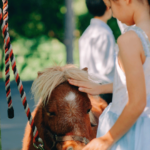
15 Jan Perish The Princess
Nitsa Stylianou worries about fantasy being confused with reality.
Some women carry the idea of being a princess with them into adulthood and motherhood.
I have been struggling with an internal difficulty – rejection of the image of little girls dressed up and parading as princesses in everyday life, almost to the exclusion of any other mode. I find it surprising that despite the evolution of feminism, mothers continue to encourage (or give in to) their little girls adorning themselves as princesses. These princesses often have a related sense of entitlement about being cherished, worshipped and admired for their beauty.
As a clinical psychologist, I’ve heard many stories from mothers on the subject. Some maintain that despite their reservations, their little girls “just gravitate” to pink. Others blame the media and the proliferation of “princess gear” and related toys. But we could also ask ourselves what the fuss is, and what’s the worst that could happen.
When little girls pretend they are princesses during play, there is the understanding, however rudimentary, that they are indeed pretending. But when pretence extends into everyday life, the blur between fantasy and reality becomes problematic.
Children often are unable to distinguish between real and unreal, and herein lies the problem. Some little girls will buy into the theory they are precious. Not all parents or carers will take the time to help them understand that not everyone will feel this way about them, and that this is okay. They have other talents such as kindliness, conversational skills, intellectual prowess and so forth.
Princesses are ideal, but not real.
Some women carry the idea of being a princess with them into adulthood and motherhood. These women can’t (in part) cope with the reality of their lives. Because even if their circumstances are good, they can’t compare with the ideal, and they become depressed. Some go the other way and develop an exaggerated sense of self-importance, and with it an increasingly tenuous grip on reality, most notably financial reality.
Princesses are ideal, but not real. They don’t know much about calculus, neuroscience, paying bills, coping with frustration, delaying gratification, tolerating distress, or being altruistic. Unlike real princesses, who have perfunctory engagements and might do work for people less fortunate than themselves, identifying exclusively with the image of a princess encourages passivity and an expectation that things will come to you.
We have to start the ‘girls of substance’ movement
And here’s where it gets complicated, pathological even. Little princesses grow, and some get teased – for their size, looks and/or image. It shatters the ideal. They feel teased, bullied and helpless at problem-solving. But problem-solve they do: with diets, surgical procedures and makeovers. Some turn to compulsive shopping, others turn to substances to dull the pain.
This is usually where I come in. Diagnoses of depression, anxiety, anorexia and poor self-esteem fill my files. Not just because of the princess complex, but the princess can be found in all fragile women, ingrained and blueprinted. Inner tattoos, I call them.
We have to start the ‘girls of substance’ movement, I tell a friend over lunch. The waiter comes up and asks us if we would like to try a piece of fairy cake on the house to share (I kid you not). He seems to assume we’ll be flattered and welcome his suggestions on portion control. ‘Fairies! Don’t get me started,’ I think. But not wishing to take down the messenger, we tell him we’ll have the Mongolian lamb salad – a good and nourishing choice for women of substance.
Dr Nitsa Stylianou is a clinical psychologist based in Sydney.



